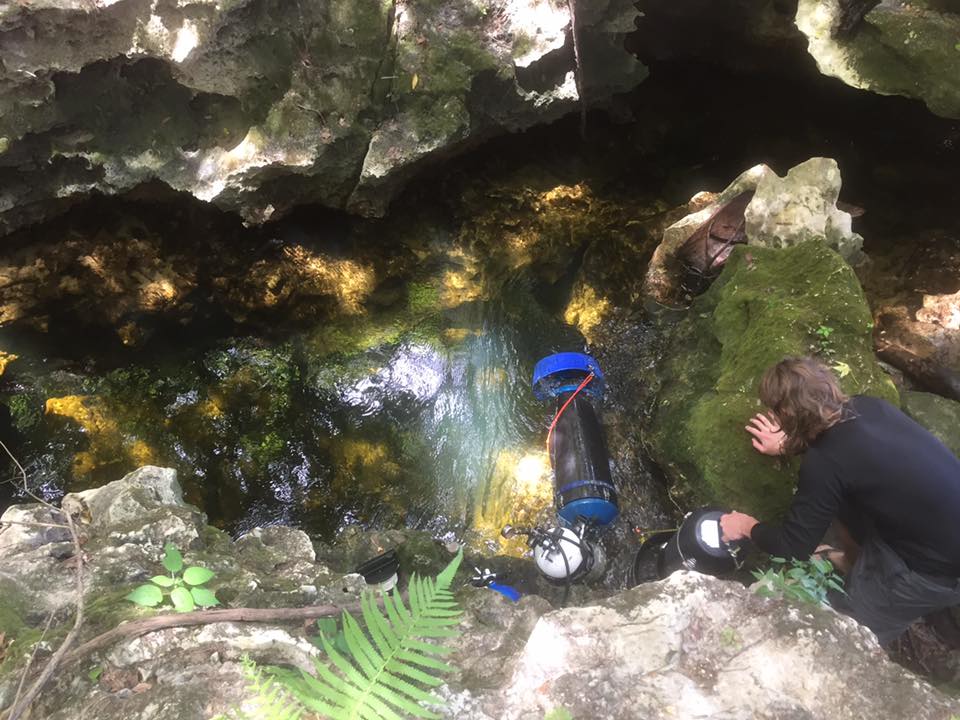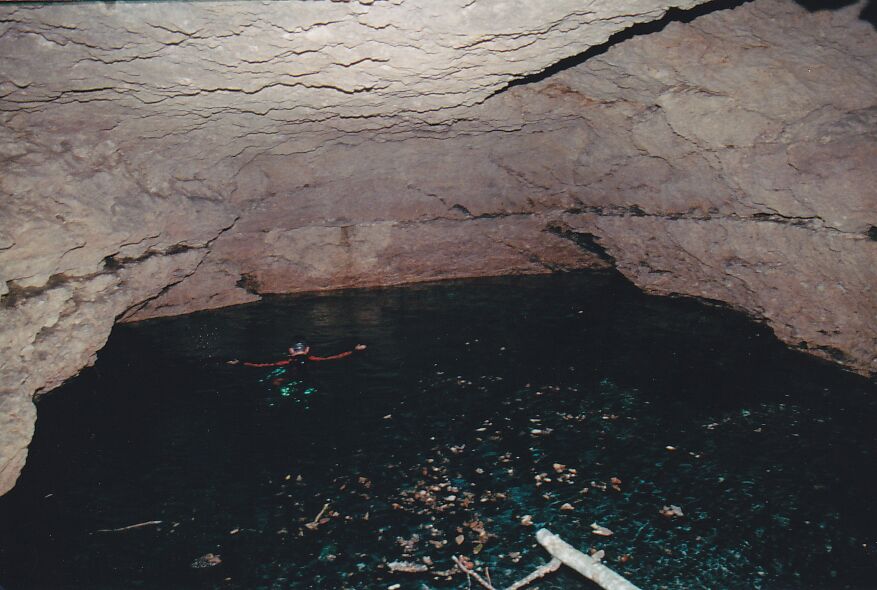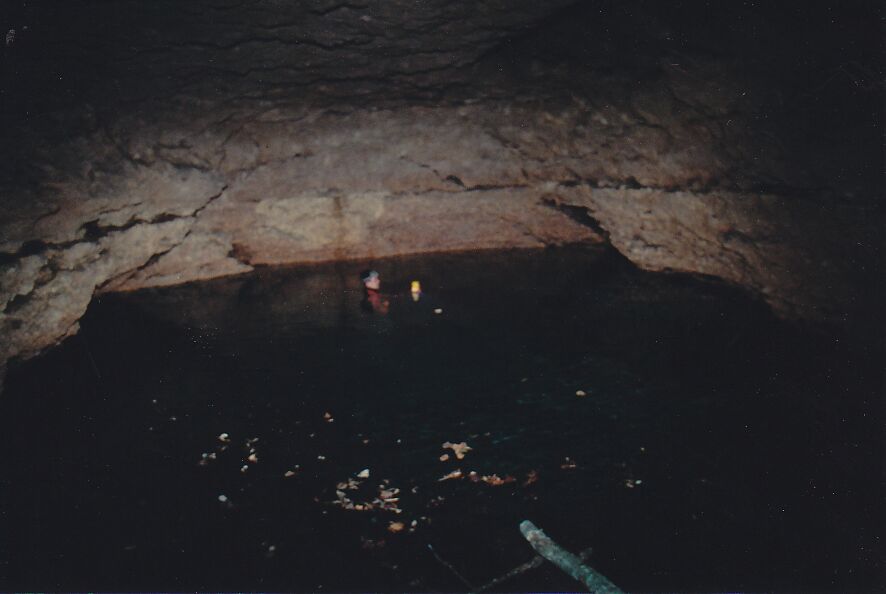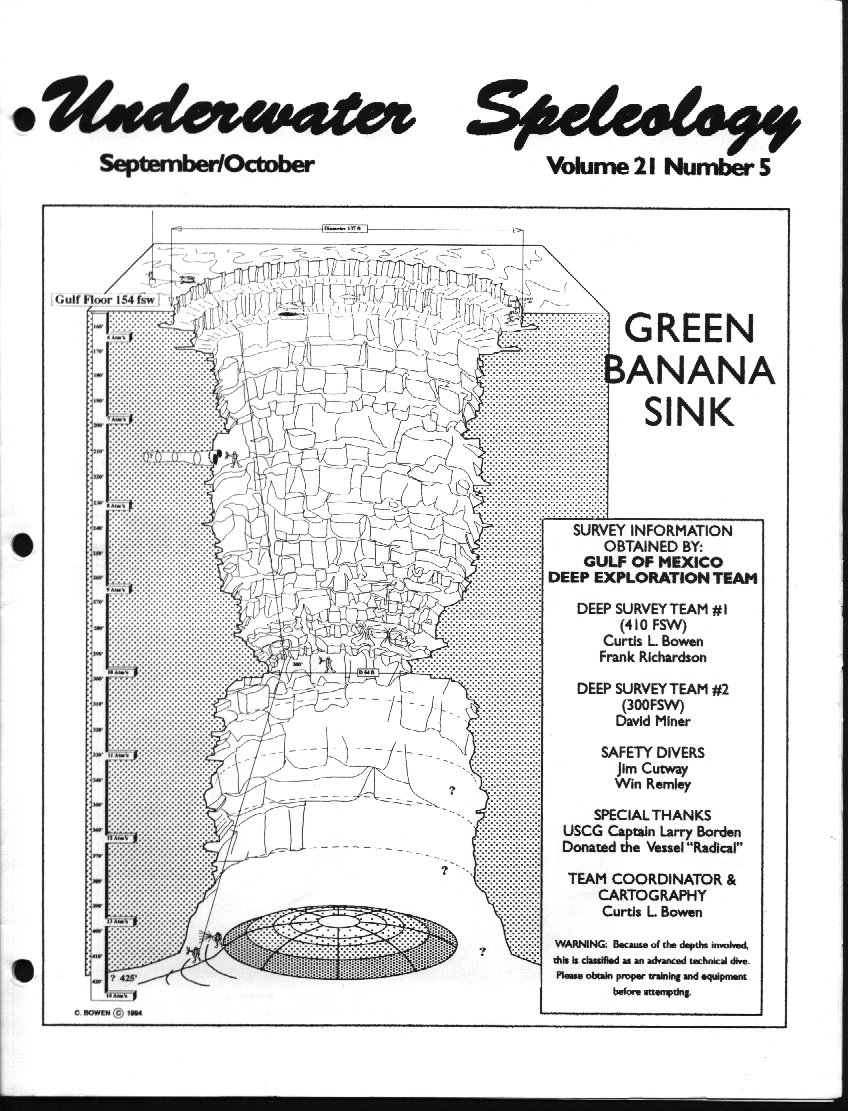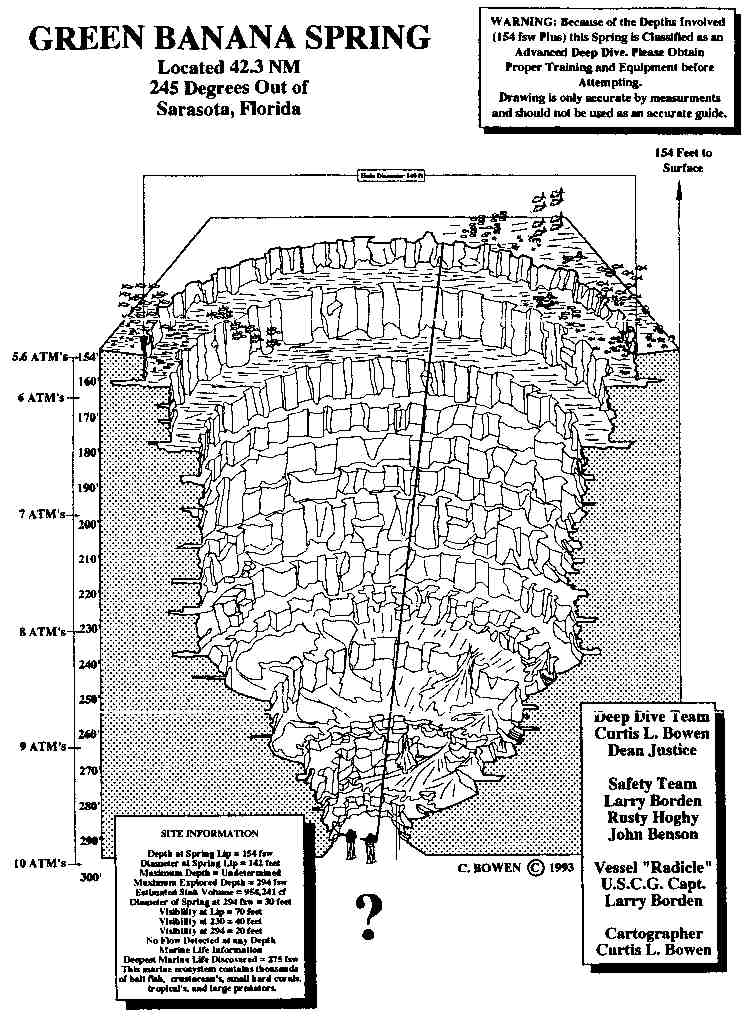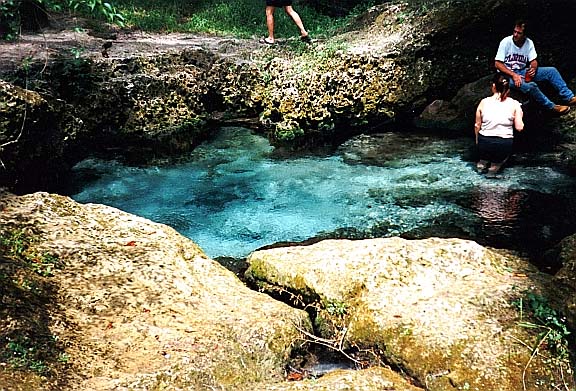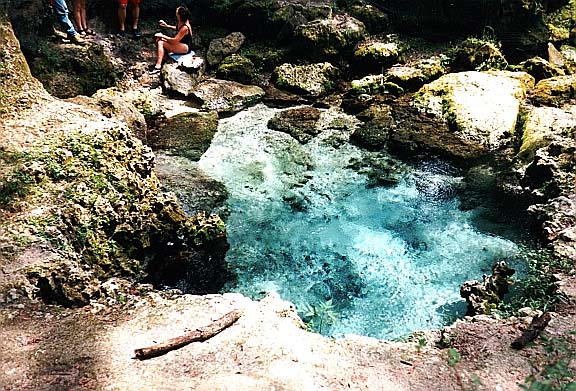"The Littlest Spring"
or
The Exploration of Branford Spring
When describing underwater caves, there are a few descriptive phrases commonly used to denote caves that the average or student diver is usually warned away from. For many years the older, usually wiser, and definitely alive instructors have warned inquisitive students away from hazardous caves by saying, "Oh, you don't want to go there, it's low and silty"; Or "It's pretty dark and deep," along with a disdainful look. Of course the latter always referred to caves near Tallahassee, Florida and the other, anything that was smaller than Peacock Springs in Suwannee County, Fl. I know both these phrases well. As a student of a conservative and safety conscious instructor, I heard these phrases often, usually in conjunction with cave names that had been out of my skill range at the time. What I failed to understand was that these warnings were also given to less skilled divers in the hopes that they would not venture near caves that were being protected for their beauty or fragility. It took a trip back home to Colorado and some Colorado caving to learn the fine difference between "There's no caves there" and "There's no caves to speak of there." This realization made me wonder whether or not some of the caves I had been warned away from a few years back had really been as bad as they were described. In May I had the opportunity to travel back to Branford, Fl. for a month of continuous cave diving, which I spent diving caves that I had not bothered to look at previously. One of the most notorious caves of this type is Branford Spring, just below the Branford Dive Shop in where else, but Branford, Florida. As long as most people can remember, the only information about this spring had been vague rumors that it was really small, no-mount, and very silty. Of course no one that I asked had ever actually been past the cave entrance despite the strong flow and crystal clear water which causes boils on the surface easily visible from the parking lot above. Since the first day I looked down from the tank fill station above the spring I had always wondered what the cave really looked like. In the late 1960's Branford spring was originally known as Twin Spring. A small picture of Twin Spring hangs in the Branford Dive Center, near the front door. If one looks at the picture long enough, one might notice that the sinkholes are much more pronounced than they are now, and in fact are more reminiscent of the upstream sinks at Telford, which slope down sharply to the water level. Of course, the platforms from which the kids fling themselves into the water are not in the picture. And neither is the Branford Dive Center. What you may fail to notice is that, though there are two sinks in the picture, it is in fact the same area that now holds only one large spring. How is that possible? In the picture there are definitely two sinks, of which the upper one is closed off, and does not have a run or outflow, and the lower one seems to be flowing strongly, much the same way that Branford Spring does now. To begin, you must understand the viewpoint of the photo. The photo was taken from the direction of the highway (which did not have the large bridge then) towards what would become the Branford Dive Center.
The lower, closed sink is actually where the flowing Branford Spring is now. The upper spring is in the same area that is now a shallow depression in the Branford Spring run, heading towards the Suwannee River. Now that we are oriented, how did the changes take place? Though the method is definite, the reasons are a little more vague. In the late 60's the City of Branford dynamited the entrance shut. Rumor has it that the cave was destroyed over concern for the lives of local swimmers and children, who enjoyed free diving into the entrance. Of course this is totally unsubstantiated, but it does make sense in light of the rather unpopular view of caves that the locals had during that time. However, viewing the proximity to the highway, and in light of debris found in the cave, I believe that it may have been filled in as a consequence of the construction of the highway. When the city needed to construct a suitable abutment for the large bridge that is now in place, I imagine they found the proposed highway too close to the original spring and rather than alter the route, they found it easier to fill the cave entrance. Regardless of the reasons, the geographical changes were drastic. The entrance to the lower spring was entirely closed. The large berm between the springs was removed, either entirely, or low enough for the upper spring to carve a run through the remaining earth. The upper spring began to flow heavily, burdened with the flow from the now closed lower entrance. It is possible that a large room within the cave was entirely collapsed, and another entrance buried all together. The flow of the spring was altered permanently. My first diving exposure to Branford Spring was late in my month of diving. I was testing a new side- mounted tank set up in preparation for sump diving back in Colorado. I had decided to use Branford Spring as I could get in and out of the water easily to get materials from the dive center, should I have overlooked anything. Once in the water I began to poke around the entrance of the cave, as there isn't really much else to look at in the basin. The entrance was easily side-mount passable but large chunks of cement and rock had fallen (or been pushed) into the entrance, blocking passage. The digger in me took over, and I spent about fifteen minutes hauling huge chunks of cement block out of the hole. I easily opened the passage to a size that I felt safe entering, and moved the debris far enough up the slope into the basin that I was sure it would not roll back in, blocking my exit. Once in, I was surprised to find that the cave actually opened up into a room that I could have taken backmounted tanks into. The excitement began to grow, and I pushed in further, and found the permanent line a little further in. With my sidemount tanks, I was feeling pretty good about looking at some low stuff, so I backed out, and laid a jump reel to the main line across the 10 feet to the entrance. No reason to die for something as stupid as ten feet. I continued in, and as the passage turned to my left, it began to get a little smaller. I pushed on until I came upon a small green bucket. To my dismay the line stopped and the floor and ceiling came together into at first what looked like impossible passage. I pushed my head into the restriction, but with all my gear I could not get my shoulders in. Once again I backed out, and rethought my plan. On the surface, I decided that I needed to find out a little information about this cave, to see why the line stopped, and if it might really go. My first and best source of information would be Gene Broome, proprietor of the Branford Dive Center. Gene and I have been friends for about a year, and he has listened to me rattle on about my caving adventures for every caving day of that year. Gene has been diving the Branford area since the 60's and takes great pride in counting on less than 10 fingers the number of active cave divers that there were in the area before him. He usually has very in-depth knowledge of the caves in the area. From the look I got when I asked, I knew that this would be no different. "Why do you want to know?" "Oh, I was just down there poking around." Look of suspicious surprise from Gene... "How far did you get?" "Oh, not far, back to a green bucket, maybe fifty or sixty feet, and 26 feet deep." Sly, knowing grin from Gene... From there, we adjourned to his office, where he told me his story of Branford Spring, and set out the stakes, so to speak. Apparently, in the late sixties, Gene had been digging in the spring in the hopes of breaking back into trunk passage. He had pushed past the spot where I was and worked into another restriction where he was digging, when a train passed on the nearby tracks above. The din was terrifying, and as any digger can attest, anything that sounds like a huge rockslide in an already precariously dug passage, brings immediate thoughts of being buried alive. Underwater the noise was hugely magnified, and Gene dropped his digging tool and hauled ass, never to return. But just before he left, he swore that he could see where the passage opened up ahead, and he was sure that it got much larger. That was it. I was very interested now. His last words, "tell me when you find my shovel" had set the challenge, along with the assurance that the first restriction was definitely passable. That same day, I prepared a new equipment setup to re-enter the cave and take another look. I left the sidemount rig behind and adopted a single aluminum 80 cubic foot tank with a "Y" valve. I attached a single small backup light so that it rode alongside the tank, tucked under an innertube. I had decided on one light only, as I knew that coming back out was always accomplished in zero visibility, and a light failure would present very little if any additional complications. This presented the smallest possible tank configuration with three sides of the tank bare, and everything tucked onto one side. I decided that due to the size of the passage, fins would be more hindrance than help, especially if I had to back out any length of passage. A Buoyancy vest was also ruled out, as it presented too much of a vertical profile in the squeezes. Frog kicking, and fasting the Y-valve with one hand I discovered that I had pretty decent control of the tank and with a little help from controlled breathing, my buoyancy. I re-entered the cave and began to lay line. By traveling slowly I was able to worm through the smallest passage I have ever been in, wet or dry. I was forced to hold my regulator sideways in my mouth, as the hose prevented it from staying sideways with my head. I was constantly worried of losing my mask as the limestone was scraping both sides of it in the small passages. There was little digging to be done in the first passage, as it was hard limestone floor and ceiling and brushing aside small debris was the extent of it. In places there were low pockets that had to be scooped clear of debris. This created zero vis conditions, but as there was nothing to look at and I could feel every inch of the edge of the cave without moving, I was not worried about losing my way. It took three days to reach where Gene had been digging, perhaps sixty feet into the cave. A round trip of 120 feet typically took forty-five to fifty minutes, and an entire tank of air. The early parts got easier day by day, but each new piece of cave required that I learn a "system" for getting through the restrictions. On the third day I reported to Gene that I thought I was were he had been,. and that I too could see where I thought the cave might open up! There was some confusion as I had not seen his shovel, and of course there was no way that I could have missed it, but we later decided that it may have rusted away or something else. The next day I entered the cave, determined to make it to the large passage. I cruised through the first restriction, barely even stopping to wriggle. I soon reached the far end of the second restriction where I was stopped cold by a "nubbin" hanging from the ceiling. It may have been only about two inches long, but in a passage less than eight inches tall, it made all the difference. I became quite worried as I realized that I could not dislodge myself from the nubbin, and unlike in dry passage, I had a very definite time limit imposed by my small air supply. I was unable to move to either side, as the passage closed together a mere hand's width on both sides. I could not move forward as I was pinned between the shoulders, and my arms were squeezed to my sides, preventing me from bringing them forward to push myself back out. I had made the cardinal crawler's sin, and crawled with both arms behind, rather than one arm forward at all times. I was stuck there, unable to move for nearly five minutes, before I realized that all I had to do was get one shoulder around the nubbin. This realization that I could pass the obstacle, if only I could live long enough to get out, forced me to calm down and think out my situation. I decided to make another cardinal caving sin, and exhale all the way, to try to extricate myself. This dangerous trick worked, and I was soon free to try again. The second time I inched forward with one arm ahead of me, and was able to squeeze past the horrible nubbin, to my first glimpse of the cave to come. After three days of super thin cave, the next passage looked like Carlsbadesque borehole cave. I very nearly screamed in my regulator. I looked out into a huge room, the ceiling and floor sloping away from me, and the walls arching beyond my light's beam at an obtuse angle. Looking at my tank gauge, I realized that in my struggles I had reached one-third of my air supply, and had to leave through the torturous exit. "Gene! Gene! It goes! I hit Borehole! Gene!" "What? Where? Did you find my shovel?" "No, no, but it goes! I got into a huge room!" "How big?" "I dunno, maybe 150 feet long and 75 feet wide!" (Of course, my light beam only penetrated 15 or so feet, or was absorbed by the tannic acid stained walls, and there was no way I could tell how large the room was, but theatrically it sounded great!) "I knew it! I knew it was going to break into something big!" Gene actually looked like he was relieved, perhaps because he was finally finding out that "his cave" was more than just a small phereatic water conduit with nothing large behind it. Over the next week, I surveyed the cave, eventually finding the upstream water source, which dropped to a depth of 101 feet. This is extremely promising, as most of the trunk cave in the area is at this depth, and I hope to break into more passage. Unfortunately as I left the line, it had entered a wide, low area, and had again become no-mount territory. It is possible that in my hurry, I have missed a side passage, or taken a wrong turn in the last room. In fact, my dreams are filled with small squeezes that open into huge pits and gigantic chambers. At this time I must make a safety note concerning this cave for all of the would-be explorers and lead scoopers. This is not a no-mount training cave. This is the real thing. There are continuous areas of passage which are LESS THAN 8 INCHES in height! It would be easy to make it past the first restriction, into the relatively large area between the two restrictions which approaches 12 inches in height. If a diver were to have difficulties here, or later on, a body recovery would NOT be impossible, as there is no way for another diver to enter the cave at the same time to manipulate the victim. Yes, once there is nothing left but bones and wetsuit, a diver could probably remove the victim, but at that point, I might be more tempted to leave the victim in a cranny as a warning. If you want to test your mettle, head to Little Devil cave at Ginnie Springs. Push a bottle through the entrance restriction on the small side. This entrance is still 3 inches larger in height than the restrictions in Branford Cave, and a good bit wider. Another test would be to lay a 4x8 sheet of plywood on top of four 8" scuba tanks at each corner. Have a buddy stand on the plywood, while you crawl underneath with mask and regulator. accounting for the flex of the plywood, this should roughly approximate the squeezes in height. As you will soon realize, the squeezes are beyond the skill and finesse level, and have been reduced to the sheer physical size of the diver . Exploration will no doubt continue, whether it is Gene Broome, myself, or someone else slight of build, but for all you guys and gals out there considering it:
"You don't want to go there; it's small and silty..."
Jason Richards
NSS/CDS 41539













